In this new series, Human, paleoanthropologist Ella Al-Shamahi reveals our incredible story across 300,000 years of human evolution and how – with the help of the latest discoveries – we’re learning that the story is stranger and more surprising than we ever imagined.
When Homo sapiens emerged in Africa we were not alone: there were at least six other human species alive at the time. Across five episodes, Human examines how we went from being just one of many types of human to the dominant form of life on the planet. It’s an extraordinary story, spanning many millennia, but for 99% of it we have no written record of what happened.
Now, following breakthroughs in DNA technology and remarkable fossil evidence, Ella Al-Shamahi is able to tell us this story in startling detail: from the discoveries in Africa revolutionising our understanding of how our species began, to the caves of the Americas where we hunted ferocious ten foot tall prehistoric bears, and the stories of the other human species - like Neanderthals - and the role we played in their demise. And she’ll draw on the latest scientific evidence to learn how the lives of our ancestors shaped who we are today.
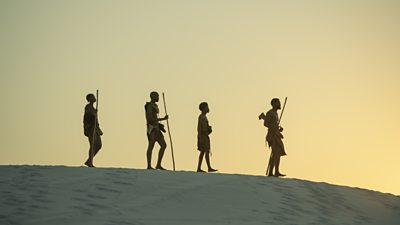
Episode 1 - The First of Us
The first episode tells the extraordinary story of how our species, Homo sapiens, first emerged and how the discoveries of recent years are revolutionising our understanding of our origin story. In Morocco, we find out that Homo sapiens are 100,000 years older than previously thought; we discover how we were nearly wiped out by violent climate change but clung on against the odds; and in a cave in Botswana evidence of complex rituals reveal Homo sapiens culture was flourishing in ways that still shape us today.
- When Homo sapiens emerged as a species, there were at least six other human species on Earth. BBC’s Human series features:
- Homo erectus: Lived between approximately 1.89 million - 110,000 years ago, initially in Africa, then later across large parts of Asia and possibly to the fringes of Europe.
- Homo floresiensis: Lived between approximately 700,000 – 50,000 years ago. Fossil remains found exclusively on the island of Flores in Indonesia.
- Homo neanderthalensis: Fossil evidence of this species dates between 430,000 – 40,000 years old, but DNA evidence suggests they may have existed even earlier. They lived across a large swathe of the Middle East and Central Asia, and throughout Europe.
- The Denisovans: Diverged from their common ancestor with Homo neanderthalensis approximately 440,000 – 390,000 years ago. DNA recovered from the soil in Denisova Cave in Siberia dates to between 206,000 – 294,000 years ago.
- The oldest fossils that are recognisably our species, Homo sapiens, come from Jebel Irhoud in Morocco, North Africa and date back to around 300,000 years ago.
- For a long time, it was thought that our species evolved in one place - probably in East Africa. However, it turns out we were likely formed from a mixture of groups across Africa intermingling, like a big melting pot. This is known as the Pan African Evolution theory and has gained traction within the last decade.
- These early Homo sapiens prototypes would have looked familiar to us, but they were all slightly different and would have had some ancient features like heavy brow bones or elongated skulls. As Homo sapiens evolved, we lost our brow-ridge – and our flat face, very unusual in the animal world, is a defining characteristic of our species.
- Homo sapiens are very good at abstract thinking – the ability to imagine things that don’t exist. This gave us the potential to invent weapons like the bow and arrow because we could imagine that string & bowed wood would launch a projectile. Abstract thought also gave us the capacity for ritual and spirituality.
- Your teeth contain a kind of clock. When teeth are growing, the enamel inside forms layer by layer. These layers cause a microscopic line to form about once a week – a bit like the yearly rings inside a tree. They can be counted to calculate the age of the owner.
- Homo sapiens children spend much longer in childhood than the children of ancient humans, like Homo erectus. The advantage is that it gives our children longer to learn how to live in our complex human societies.
- Climate change likely wiped out the longest lived human species. The last known Homo erectus lived in Java, Indonesia. Around the time they went extinct, the climate got more humid, causing their open woodland habitat to turn into dense rainforest – a notoriously challenging environment. Scientists believe our species, Homo sapiens, is the only type of human to have mastered life in the rainforest.
Species Spotlight
- Homo erectus was the first human to walk like people today. They made good use of this skill – they were the first humans to leave Africa.
- Homo erectus may have been the first humans to control fire. 780,000 year old charred fish remains found in present-day Israel might have been cooked by Homo erectus.
- Homo erectus lived for a very long time – almost 2 million years. That’s about 6 times longer than many archaeologists believe our species, Homo sapiens, is thought to have existed.
- Homo erectus were responsible for the invention of the hand axe, a major advancement from earlier stone tools. But they might have hit a bit of a technological stumbling block – it seems their tools never became any more sophisticated over hundreds of thousands of years.
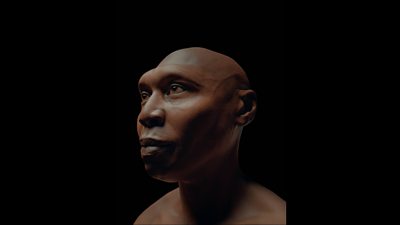
Episode 2 - Into the Unknown
In the second episode, we follow our ancestors as they step out of Africa and venture into the wider world, into areas inhabited by other human species.
Around 60,000 years ago, a small group of Homo sapiens migrated into the Middle East. Recent DNA discoveries tell us that every human alive today, whose origins are from outside Africa, are descendants of this group. In just a few thousand years they spread across the globe. Paleoanthropologist Ella Al-Shamahi visits the rainforests of Sri Lanka and discovers how we became the only human species to make the unforgiving jungle our home using innovative techniques like hunting monkeys with arrowheads made from monkey bones. On the Indonesian Island of Flores, she finds out about another human species – the tiny Homo floresiensis, often referred to as the ‘The Hobbit’ due to its small stature similar to the characters in The Lord of the Rings. And finally, Ella asks how our ancestors became the first human species to make the sixty-mile journey across open ocean to Australia around 45,000 thousand years ago.
- Every human being outside of Africa comes from a small group of Homo sapiens that successfully migrated from Africa through the Middle East around 60,000 years ago and may have numbered only a few thousand people.
- Around 45,000 years ago, Homo sapiens crossed 60 miles of open ocean to reach Australia.
- A tiny species of human called Homo floresiensis lived on the island of Flores in Indonesia until around 50,000 years ago. They were only about a metre (3 and a half feet) tall and had long feet compared to their legs, which earned them the nickname ‘The Hobbit’, after the characters in J.R.R. Tolkien’s Lord of the Rings books. They also had small brains, around 1/3rd the size of ours – not much larger than that of a chimpanzee.
- Homo floresiensis weren’t the only unusually-sized creatures on Flores. They lived among elephants that were the size of cows, giant rats that weighed 8 times more than common brown rats, and huge meat-eating storks that stood at almost 2m tall. This was all probably the result of the ‘island effect’ – a phenomenon where large animals get smaller due to fewer resources, while small animals grow bigger due to lack of predators.
- Scientists believe our species, Homo sapiens, is the only type of human to have mastered life in the rainforest. In what is now Sri Lanka, our ancestors adapted to this challenging environment by making arrow tips out of light-weight monkey bones and developing a piercing tool called an awl, which may have helped them tailor tightly-fitting clothing to protect from insect-borne diseases.
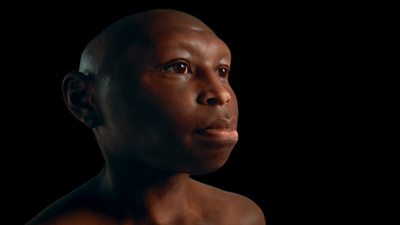
Episode 3 - Last Humans Standing
In this episode we look at the shocking new insights into the demise of our sister species, the Neanderthals, our possible role in their downfall, and how we become the last human species on Earth.
Around 55,000 years ago, Homo sapiens ventured into Europe, only to find it was already occupied by Neanderthals who had lived there for almost 400,000 years. Ella Al-Shamahi finds out just how close our two species became when she sees evidence that we interbred. She reveals how during the Ice Age in Europe, Neanderthals held the evolutionary upper hand with a physiology better built for the cold. Yet, against the odds, by around 30,000 years ago we were the only species left. As she explores the demise of Neanderthals, Ella visits the ‘tunnel of bones’ in El Sidrón cave, Spain, where archaeologists have found the remains of thirteen Neanderthal family members who were murdered and cannibalised.
- We interbred and had children with at least two other species of human – Neanderthals and Denisovans.
- Every person with ancestry outside of Africa has Neanderthal DNA, some up to 4%.
- Around half – and possibly as much as two thirds – of the total DNA Neanderthals carried in their genes [the Neanderthal genome] is spread across modern human populations living today.
- The stereotype of Neanderthals as brutish and unintelligent has persisted since they were first discovered in the 19th century – but we’ve had them all wrong. Archaeologists have uncovered evidence of Neanderthals artistic side, using eagle talons as ornaments and collecting beautiful feathers, which may have been used to create headdresses or capes.
- At the time our species lived alongside Neanderthals in Europe more than 40,000 years ago, members of our species still had darker skin adapted to African climates, whereas European Neanderthals may have had lighter skin - and some are believed to have had red hair.
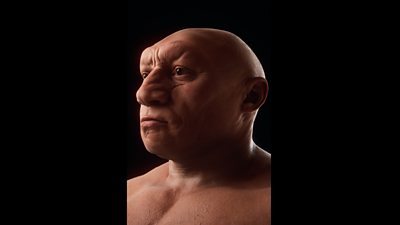
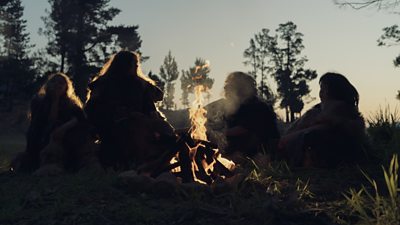
Episode 4 - Discovering the Americas
During the height of the Ice Age, one of the coldest times our species has ever known, we stepped into the last habitable continent on the planet: the Americas.
Paleoanthropologist Ella Al-Shamahi discovers how we were confronted by ferocious ten foot tall prehistoric bears in this new land, and the daredevil hunting techniques we used to take them down. As we make our way deeper into the interior of the North American continent, Ella traces the fossilised footprints possibly of a mother and her child who were among the first to set foot in North America. She learns how the humans who lived here hunted vast herds of Ice Age mammoths and giant sloths, until a changing climate and our innovative hunting techniques combined to push them to extinction. Forced to adapt our ancestors pioneered new ways to control nature as farming emerged to shape our world.
- Over 20,000 years ago, an ice sheet around 2 miles thick covered the top half of North America, from Canada to as far south as modern day New York City.
- Three quarters of species of large land mammals in North America went extinct by around 12,000 thousand years ago. Climate change was a major contributor to the demise of many species, with changes in the vegetation in different parts of the continent causing disruption to their habitats, but human hunting likely also played a role in pushing them over the edge.
- Farming was invented in at least 11 different regions across the world within a 8,000 year period – from the Middle East to New Guinea to Central America.
- 60% of the calories consumed by humans worldwide come from just 3 species of plant that were domesticated between around 11 and 9,000 years ago – wheat (originally from the Middle East), Rice (Asian rice originally came from what is now China) and Maize (or ‘corn’ - originally from present-day Mexico).
- Some of the first people of the Americas hunted megafauna (giant mammals). They took on American Mastodon (an extinct species of elephant weighing up to 11 metric tonnes), giant sloths (some weighing up to 1.5 metric tonnes), and Columbian Mammoths (up to 12 metric tonnes).
- We know mammoth was on the menu thanks in part to a recent study that analysed the diet of a woman living in the Americas around 13,000 years ago. Mammoth made up about 40% of her diet, meaning her eating habits were similar to [a type of] sabretooth cat.
- It’s thought early hunters in America used a clever bit of technology to boost their hunting prowess – the spear thrower. To modern eyes, this tool looks a bit like the toy dog-owners use to throw tennis balls during a game of fetch - and it works on a similar principle to launch spears farther and faster. Spear throwers can be used to equally deadly effect by both male and female hunters, meaning early groups using them would have been formidable predators on the plains.
- Dogs might have been humans’ best friend for as long as 40,000 years, beginning when we tamed wild wolves. Dogs were the first animals we domesticated and they helped our ancestors by guarding camps, taking part in hunts and pulling sleds.
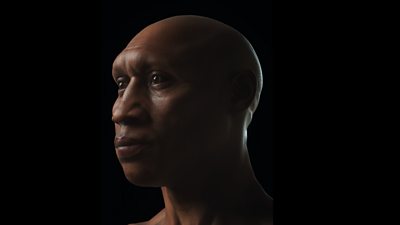
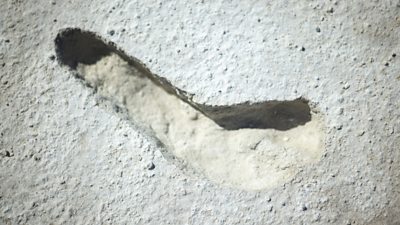
Episode 5 - A Great Gamble
Around 12,000 years ago, as the Ice Age finally thaws, humanity makes a dramatic shift abandoning nomadic life for permanent settlements. In Turkey paleoanthropologist Ella Al-Shamahi visits the world’s oldest temple Gobekli Tepe, and one of the largest early towns, Çatalhöyük - a prototype in urban living with no streets and honeycombs of dwellings accessed through the roofs. But living in densely populated towns, with livestock alongside them and dead ancestors buried beneath their houses, brought new challenges: disease and evidence of unrest and brutal violence. In Egypt Ella finds out how cities began to thrive rather than collapse. And in a turquoise mine in the Sinai desert, she discovers how migrant workers were responsible for creating the first alphabet.
- The oldest temple ever discovered is Göbekli Tepe in modern-day Türkiye. It was built by hunter-gatherers 11,500 years ago – more than 6,000 years before the construction of Stone Henge.
- When humans in what is now the Middle East began to domesticate sheep and goats around 10,000 years ago, it was part of a major lifestyle shift from nomadic to living in settlements. Farming led to the first villages and towns but it may also have led to a new era of disease. Evidence has been found of early farmers infected with brucella and salmonella – disease-causing bacteria they likely picked up from their animals.
- Writing is thought to have been first invented in two places at around the same time –Ancient Egypt and Mesopotamia (a historical region that covered present-day Iraq, as well as parts of what are now Syria, Türkiye and Iran) over 5,000 years ago.
- Writing was invented independently in at least four different places [Mesopotamia, Egypt, China and Mesoamerica] across the planet over a roughly 3,000 year period. There is no sign of any communication between the populations who invented it.
- The precursor to the alphabet was invented around 4,000 years ago by workers mining turquoise in the Sinai desert. It is now the basis for most written languages.
- Catalhoyuk, an early settlement in modern-day Türkiye, is a forerunner of the towns and cities we know today, but with some unusual differences. The houses in Catalhoyuk were tightly clustered together without streets, so people had to enter and exit through holes in the ceiling and spent much of their time up on their roofs. At night, they slept close to the bones of their ancestors, who were buried beneath the floor - archaeologists have uncovered the remains of over 60 people in one home.
Interview with Ella Al-Shamahi
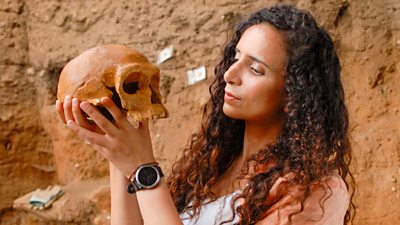
What is the series about?
For millennia we have been the most dominant form of life on this planet, so it is easy to think that we were always destined for greatness. But a revolution in ancient DNA technology and the latest fossil finds from dig sites across the world are forcing us to accept that our species’ story is far more extraordinary than we could ever imagine.
300,000 years ago, many human species walked this Earth – from the Neanderthals to Homo floresiensis - a species nicknamed ‘The Hobbit’ after the characters in J.R.R. Tolkien’s Lord of the Rings books because they were only 3.5 feet tall - to the highly successful Homo erectus and the mysterious Denisovans, to species like Homo heidelbergensis and Homo naledi. It might seem fantastical, only it was real. That was the world we were born into. We started in obscurity, we weren’t remarkable, we weren’t the smartest, nor the strongest, just the latest in a long line of human species. Yet, today, we are the only species of human left and we have gone on to build, invent and explore like no species ever has.
Using the latest discoveries this five-part series charts how this happened.
Why did you want to make this series now and what can this series tell us about life in the 21st century?
You and I were born in the 20th or 21st century but we were forged in the Palaeolithic when caves were prime real estate. This series is about us, it is our origin story and explains so much of our behaviour and biology. Our obsessive relationship with dogs and our tribalism suddenly make sense in that context, also our complicated relationship with hierarchy and our attraction to ritual, our desire to copy one another and the desire to travel, our complicated relationship with cities and farming and our strength in numbers and our creativity. Our DNA that we picked up from Neanderthals and Denisovans has been linked to a range of traits and health conditions like immunities, gut heath, addiction, COVID response and even the ability of Tibetans to live at high altitude. Many of us today have 2% Neanderthals DNA and some Denisovan DNA – sometimes as high as 6% amongst some populations. This series explains so much of who we are and where our strengths and weaknesses come from.
What are the biggest misconceptions about the human story?
There are so many! I don’t think people realise just how many other species of human we walked this planet with. It has only been in the last 25,000 years that we have been alone. I also think people assume that we erupted onto the scene and were always destined for greatness – we weren’t. We were the least experienced of all of those species. There were so many twists and turns in our story, and things you might not expect ended up playing a role.
Our demographics are also surprising – all of us from outside of Africa are descended from as few as 10,000 people who left Africa 60,000 years ago. When they left, they took only a small amount of the African diversity with them, meaning that there is much, much more genetic diversity in Africa than outside it.
Can you say what was so special about Homo sapiens that made us the dominant species?
It was likely a combination of factors: a change in brain organisation, a desire to co-operate like no other species, both of which led to better invention and creativity. This in turn meant we were able to take on different environments better than others and were not simply at the mercy of our physiology. Most people think it is about weapons, but it is also about weaving – meaning we could make better fishing nets and better clothes to protect our young. But other factors also played a role, including having a large source population in Africa from which we could replenish our numbers, the climate and a certain amount of luck.
But time and again, it is clear that our extraordinary ability to co-operate - essentially a kind of friendliness - helped us greatly and may have even driven the evolution of some of our traits like language.
What is different about this series?
I wanted to put the human in human evolution. Shows on human evolution often present it in such a detached scientific way that you could be forgiven for thinking that they are not referring to people. But these are our actual ancestors, people on our family tree, with all the emotions, fears and hopes that come with being human. I think it does a disservice to the science to see the data as representing anything less than fully realised humans with everything that comes with that.
So, in this series we look beyond the macro statistics and ask how things affect families and individuals. For instance, when we talk about the last Neanderthal, leaving the hunter-gatherer way of life, the first ritual, the first people to tame dogs, the first people to cross to Australia on rafts or invent farming - we ask how these things affect families and individuals and even what emotions might have been present. Afterall our range of emotions is a uniquely human trait and therefore part of our story.
We’re also bringing data points and archaeology to life using thoughtful, abstract and immersive drama and the musical score. In doing this we see our ancestors as not distant creatures from the past. Our DNA (and so much of your behaviour and biology) is the way it is because of them.
Was there anything that surprised you while making the series?
The science was mostly stuff I have been wanting to scream from roof tops and so that wasn’t surprising – though the story of the invention of the alphabet was new to me! But what I was actually most surprised by, was the kind of work and thinking that goes into making a BBC landmark science series. It has always been incredibly confusing to me how our origin story doesn’t get more airtime and so it was incredible to be a part of this and see the kind of brilliant work that goes into bringing the science and our story to life. I’ve never worked on a show like this, over three years with the very, very best.
Plus, it is stunning. I’ve been lucky enough to present some incredibly beautiful shows but this is on another level. The locations we were going to were either crucial for the science or made your jaw drop (often both). Some of the most arresting locations on the planet – which feels right given that we are telling the story of ‘the explorer species’.
Can you name your favourite human species and why?
I study Neanderthals and they have long been a favourite because they are our closest relative – so similar and yet not with us anymore. Though, going to the island of Flores, a long-held dream, may have tipped the balance. We visited the cave where Homo floresiensis was first discovered. This species boggles the mind and I remember how young I was when they announced its discovery and how confusing and eye opening it was. A species that is 3.5 feet tall, with a brain the size of a chimp’s, and yet was capable of making stone tools and walked upright. Plus, it lived only on the island of Flores in Indonesia with giant carnivorous marabou storks, Komodo dragons, giant rats and miniature elephant-like mammals the size of cows called stegodons – I mean come on! It just captures your imagination and you understand why they got the nickname ‘The Hobbit’ after the small beings in The Lord of the Rings. That whole world and the scientific questions they raise are almost fantastical.
As a paleoanthropologist, what it’s the most exciting part of your job and the least glamorous?
I think expeditions are incredibly exciting – they are often adventures to some of the most remote and interesting parts of the world after all! Plus, I specialise in politically hostile and unstable territories so that adds another level. Though I will say I think theory is also really, really exciting. We still have massive debates about what exactly led to Neanderthal extinction, what were the origins of Homo floresiensis, what it was that gave us the edge. Those questions, and so many others we look at in the series, are delicious to me.
Ironically the least glamorous part of my job is also fieldwork and the theoretical questions! One minute data collection or statistics in the lab is so exciting, the next is frustrating and you want to pull your hair out. Similarly one minute you are on an expedition and you have just got into a situation that could easily be an Indiana Jones script, and the next minute you are trying to wash yourself with water that has dead rats in it and is filled with larvae or you are trying to figure out how you are going to go to the toilet in a basket attached to the side of a ship.
What do you hope viewers will take away from the series?
I hope they see how absolutely remarkable and unlikely our story is – it boggles my mind and it takes my breath away and I hope they feel the same way.
I hope they feel something too – we went to the ends of the Earth to tell this story, we wanted to walk in our ancestors’ footprints and honestly the ancients sometimes made that easy for us. At one point we went to one of the most exciting sites in the Americas – the actual footprints of what is likely a mother and child, in New Mexico. They are probably amongst the very first Americans – you can see from the pressure in the footprints that at times she picks the child up, sometimes on the right hip, sometimes on the left. To get to see snapshots in time like this it’s so emotive… and human.
I also hope personally that they will see that there is a dichotomy to our success – on the one hand it’s difficult not to be impressed with Homo sapiens and if our ancestors hadn’t had this hunger to innovate and explore – would you and I even be here? Probably not. And yet, those same things that make us so remarkable, they are a trade off because they seem to be detrimental to those around us. Personally, I don’t really know what to do with that but I hope, like with all science, it gets people to think and ask deeper questions that go well beyond what we had time for in five episodes.
Interview with Matt Barret
Can you tell me a bit more about the series and its structure?
Human spans the time period from the earliest fossil we’ve found that is identifiably Homo sapiens, dated to around 300,000 years ago, to the invention of writing around 5,000 years ago. The series therefore covers our species’ entire known prehistory: the time before written history began.
That part of our human story represents around 98% of the time we know we existed as a species on this planet.
The series is chronological – each episode picks up from the previous one, to show the progressive changes that our species underwent. Each episode steps through a key chapter in our story, tracing the environmental pressures that shaped us, the other human and animal species we shared the planet with – and the biological, social and technological developments that led to our ultimate survival.
Can you tell me a bit more about the science that underpins the series?
The vast majority of our 300,000 year human story is shrouded in mystery, so to make the series the production team scoured the globe to find the latest research and the world’s leading scientists conducting it. The result is a unique collaboration, bringing together research and evidence from archaeologists, paleoanthropologists, geneticists and climatologists to piece together the story of our species’ origins.
With such a complex puzzle involving so many areas of research, the Human production team worked closely with lead Series Consultant Prof Chris Stringer from London’s Natural History Museum, and brought on a core team of over twenty world-renowned academic consultants each with their specialisms. In addition, the team consulted with dozens of research scientists working on every specific detail of the human story told in the series. These experts provided key guidance that helped shape the dramatic stories the series tells, and enabled the rigorous attention to detail that runs through every aspect of the series – in both the content and the visuals.
Much of our understanding of what ancient humans looked like and how we behaved, comes from precise measurements of fossilised skulls and other skeletal remains, the analysis of DNA extracted from tiny pieces of fossilised bone, plus scientific study of the places our ancestors lived and the tools and cultural artefacts they left behind.
Sometimes, extraordinary details of the lives of ancient humans can emerge from the smallest pieces of evidence. Fossilised footprints at White Sands in the United States, dating back to at least 14,000 years ago (and possibly as old as 23,000 years), show the person who left them slipped in the mud in a certain way because she was carrying a child, and the spacing of the footprints shows that they were in a hurry.
But equally important is what kind of a world our ancestors – and the other human species we shared the planet with – were trying to survive in. Key elements of this come from climate records, extracted from sediment cores taken in places like East Africa’s Great Rift Valley, and deep ice cores from Antarctica and Greenland. These reveal some of the environmental pressures that shaped our evolution and behaviour.
The archaeological record is sparse, and there are huge gaps in the evidence scientists have at their disposal. However, taking together what little exists and analysing it in forensic detail, gives scientists astonishing insights. Based on these, the Human series is able to paint a vivid picture of this ancient world and the events that shaped our species.
How have advances in science and technology informed the series?
All of the science in Human is based on the very latest research in archaeology and palaeoanthropology.
Two of the most significant recent advances in archaeological science, are improvements in dating technology and the ability to extract and sequence ancient DNA preserved in some fossils.
The techniques for precisely dating fossils have dramatically developed over the last few decades. For a long time, scientists were mainly restricted to using radiocarbon dating, but as it relies on the decay of carbon in organic matter, it cannot go further back in time than around 50-55,000 years. Results can also be dramatically affected by the amount of protein preserved in the fossil. Now, new methods are allowing scientists to get around the limitations of carbon dating to obtain much more precise dates from this technique.
Perhaps even more significantly, archaeological scientists now have a number of other techniques at their disposal that allow them to date objects much further back in time. These include thermoluminescence, which measures the energy from natural radiation accumulated over time in molecular bonds. This was the technique that allowed scientists to date the earliest Homo sapiens fossil, Jebel Irhoud, back to 300,000 years ago – a breakthrough that pushed back the origins of our species by at least 100,000 years earlier than previously thought. Many of these techniques are able to date not just the fossils themselves, but the objects and residues associated with human activity. In the case of Jebel Irhoud, this was dating of flints that had been burned by early Homo sapiens, and in the case of the remarkable research revealing Ice Age human occupation at Grotte Mandrin in France, it is the analysis of soot left over from cooking fires lit tens of thousands of years ago.
A second key growing area of research is the study of ancient DNA. DNA degrades over time, particularly in hot climates, and is often contaminated with the DNA of bacteria and modern-day humans. Recent technical advances have made it possible to isolate the ancient DNA with increasing precision and to sequence extremely small quantities. In addition, powerful computational tools have made it possible to compare ancient DNA sequences with the DNA of modern human populations on a large scale. Together, these techniques have made it possible to sequence entire Neanderthal genomes, and to identify a completely new human species – the Denisovans – from a fossilised finger bone. Ancient DNA analysis and comparisons with modern human populations, have also revealed that Homo sapiens interbred with Neanderthals and Denisovans – and that modern-day humans carry many of their genes.
FS
.png)



